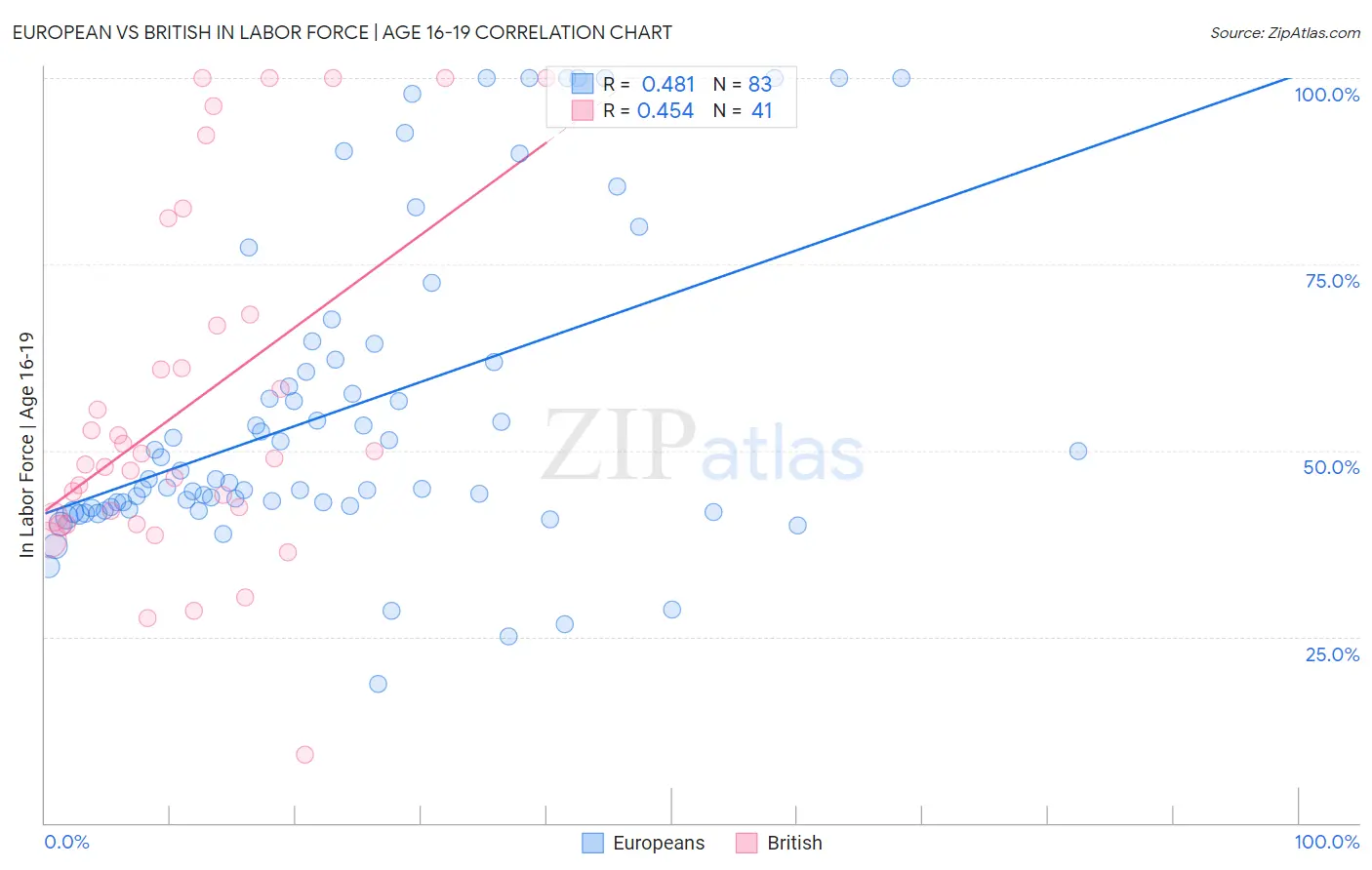European vs British In Labor Force | Age 16-19
COMPARE
European
British
In Labor Force | Age 16-19
In Labor Force | Age 16-19 Comparison
Europeans
British
41.1%
IN LABOR FORCE | AGE 16-19
100.0/ 100
METRIC RATING
44th/ 347
METRIC RANK
40.5%
IN LABOR FORCE | AGE 16-19
100.0/ 100
METRIC RATING
55th/ 347
METRIC RANK
European vs British In Labor Force | Age 16-19 Correlation Chart
The statistical analysis conducted on geographies consisting of 558,493,487 people shows a moderate positive correlation between the proportion of Europeans and labor force participation rate among population between the ages 16 and 19 in the United States with a correlation coefficient (R) of 0.481 and weighted average of 41.1%. Similarly, the statistical analysis conducted on geographies consisting of 529,284,703 people shows a moderate positive correlation between the proportion of British and labor force participation rate among population between the ages 16 and 19 in the United States with a correlation coefficient (R) of 0.454 and weighted average of 40.5%, a difference of 1.6%.

In Labor Force | Age 16-19 Correlation Summary
| Measurement | European | British |
| Minimum | 18.6% | 9.1% |
| Maximum | 100.0% | 100.0% |
| Range | 81.4% | 90.9% |
| Mean | 55.4% | 56.2% |
| Median | 46.1% | 48.9% |
| Interquartile 25% (IQ1) | 42.3% | 40.6% |
| Interquartile 75% (IQ3) | 62.2% | 67.6% |
| Interquartile Range (IQR) | 20.0% | 27.0% |
| Standard Deviation (Sample) | 21.0% | 23.4% |
| Standard Deviation (Population) | 20.9% | 23.1% |
Demographics Similar to Europeans and British by In Labor Force | Age 16-19
In terms of in labor force | age 16-19, the demographic groups most similar to Europeans are Croatian (41.1%, a difference of 0.040%), Tongan (41.2%, a difference of 0.10%), Immigrants from Sudan (41.0%, a difference of 0.36%), White/Caucasian (41.3%, a difference of 0.41%), and Celtic (41.3%, a difference of 0.42%). Similarly, the demographic groups most similar to British are Tlingit-Haida (40.5%, a difference of 0.030%), Immigrants from Kenya (40.5%, a difference of 0.060%), Fijian (40.4%, a difference of 0.090%), Lithuanian (40.4%, a difference of 0.11%), and Aleut (40.4%, a difference of 0.13%).
| Demographics | Rating | Rank | In Labor Force | Age 16-19 |
| Scotch-Irish | 100.0 /100 | #39 | Exceptional 41.5% |
| Immigrants | Liberia | 100.0 /100 | #40 | Exceptional 41.5% |
| Celtics | 100.0 /100 | #41 | Exceptional 41.3% |
| Whites/Caucasians | 100.0 /100 | #42 | Exceptional 41.3% |
| Tongans | 100.0 /100 | #43 | Exceptional 41.2% |
| Europeans | 100.0 /100 | #44 | Exceptional 41.1% |
| Croatians | 100.0 /100 | #45 | Exceptional 41.1% |
| Immigrants | Sudan | 100.0 /100 | #46 | Exceptional 41.0% |
| Carpatho Rusyns | 100.0 /100 | #47 | Exceptional 40.8% |
| Icelanders | 100.0 /100 | #48 | Exceptional 40.8% |
| Cree | 100.0 /100 | #49 | Exceptional 40.8% |
| Indonesians | 100.0 /100 | #50 | Exceptional 40.7% |
| Immigrants | Zaire | 100.0 /100 | #51 | Exceptional 40.7% |
| Immigrants | Laos | 100.0 /100 | #52 | Exceptional 40.6% |
| Immigrants | Kenya | 100.0 /100 | #53 | Exceptional 40.5% |
| Tlingit-Haida | 100.0 /100 | #54 | Exceptional 40.5% |
| British | 100.0 /100 | #55 | Exceptional 40.5% |
| Fijians | 100.0 /100 | #56 | Exceptional 40.4% |
| Lithuanians | 100.0 /100 | #57 | Exceptional 40.4% |
| Aleuts | 100.0 /100 | #58 | Exceptional 40.4% |
| Slavs | 100.0 /100 | #59 | Exceptional 40.4% |